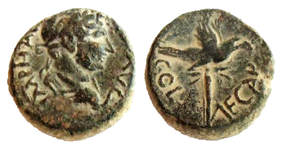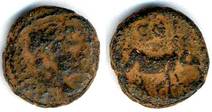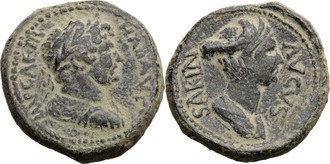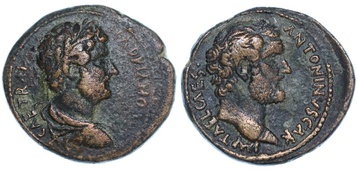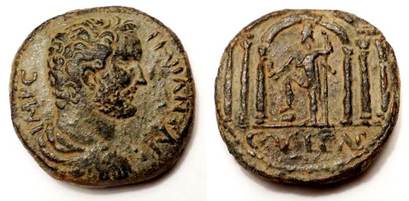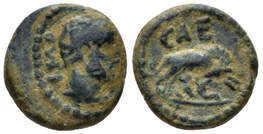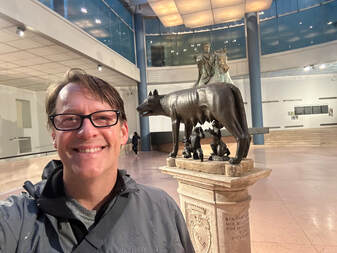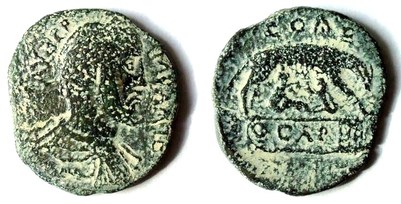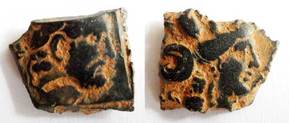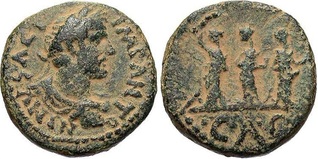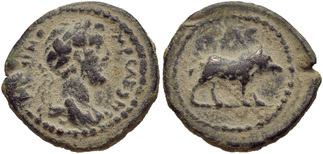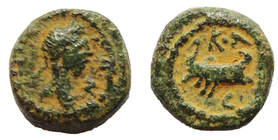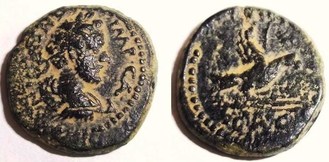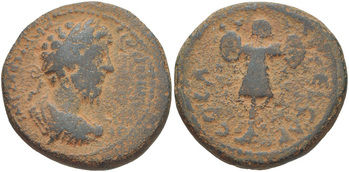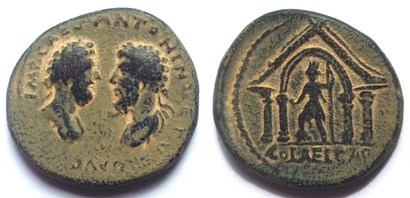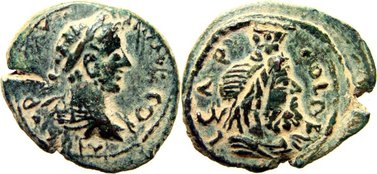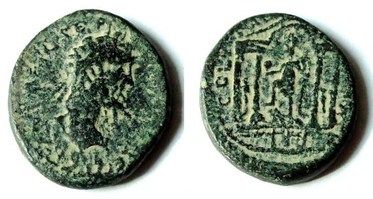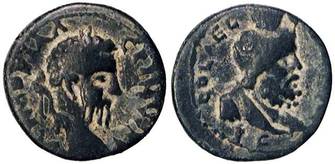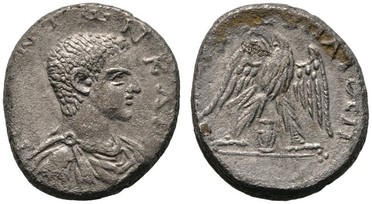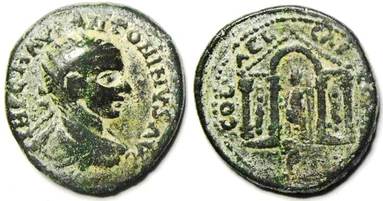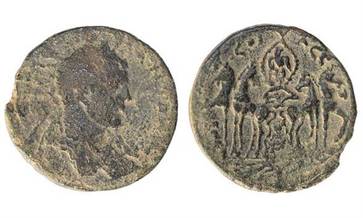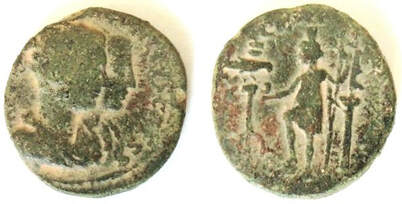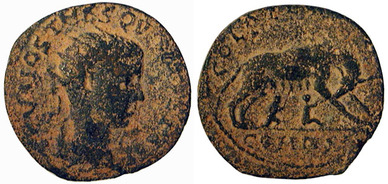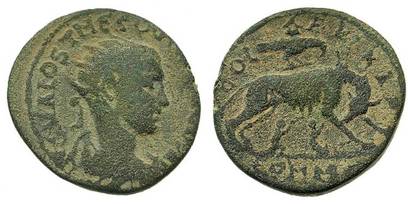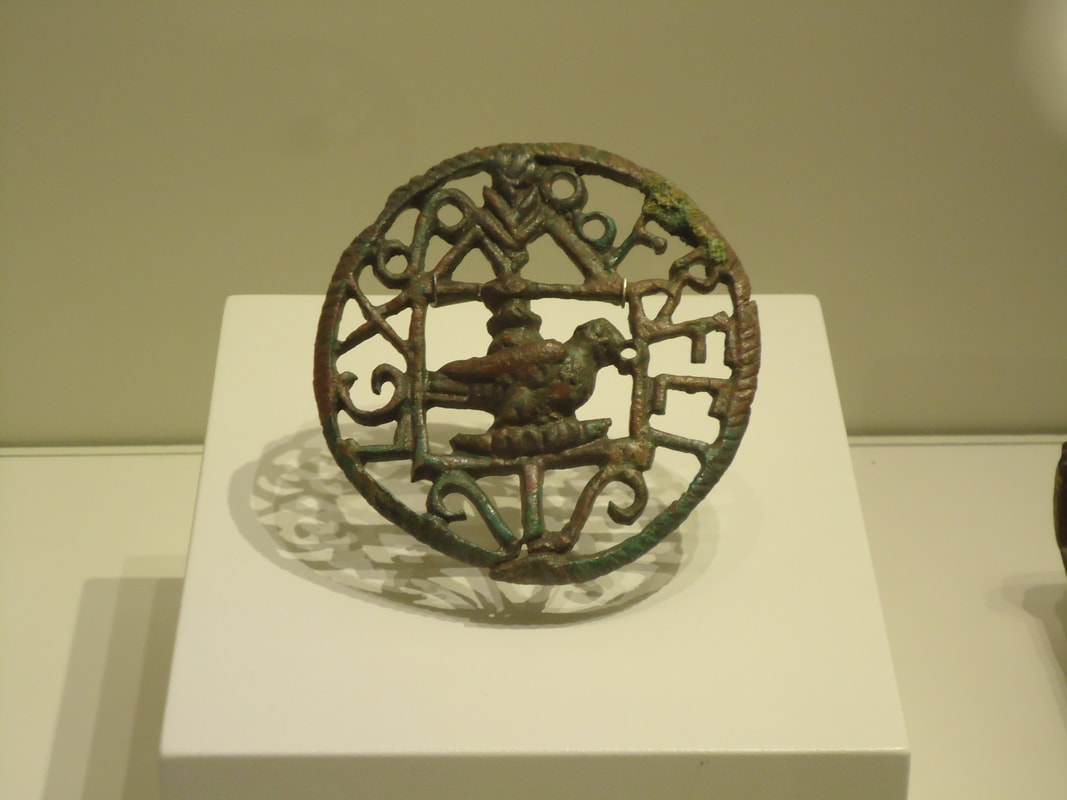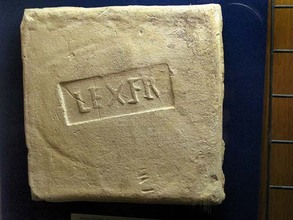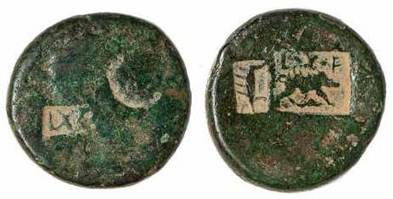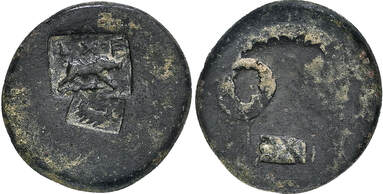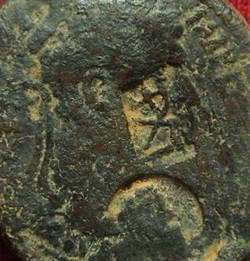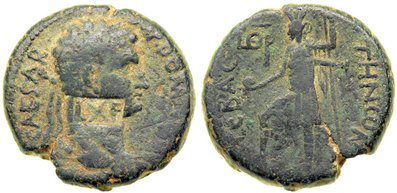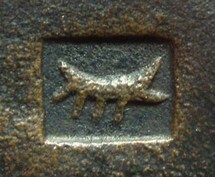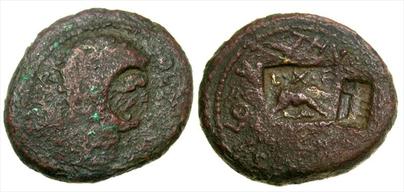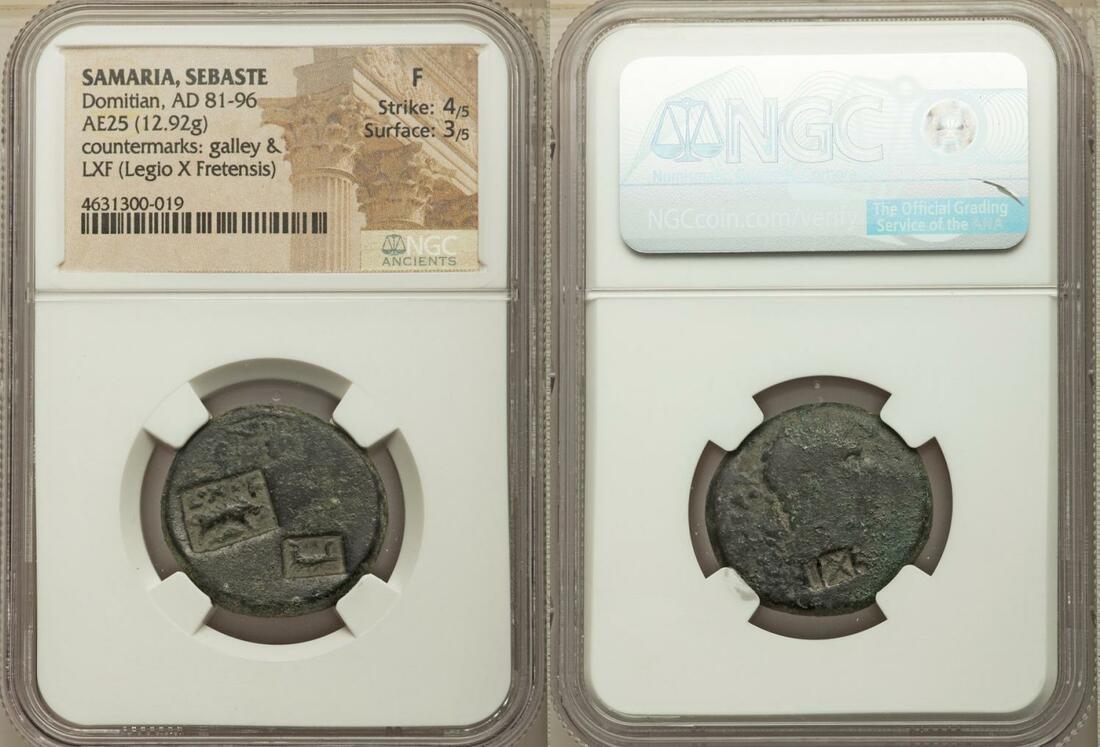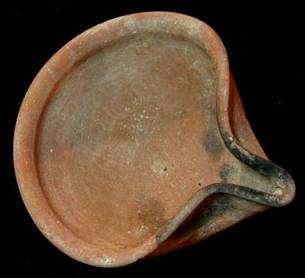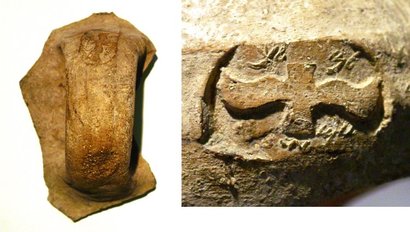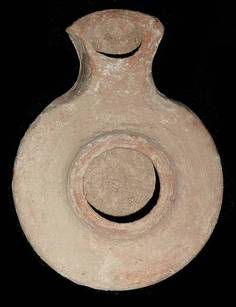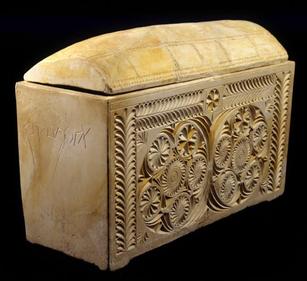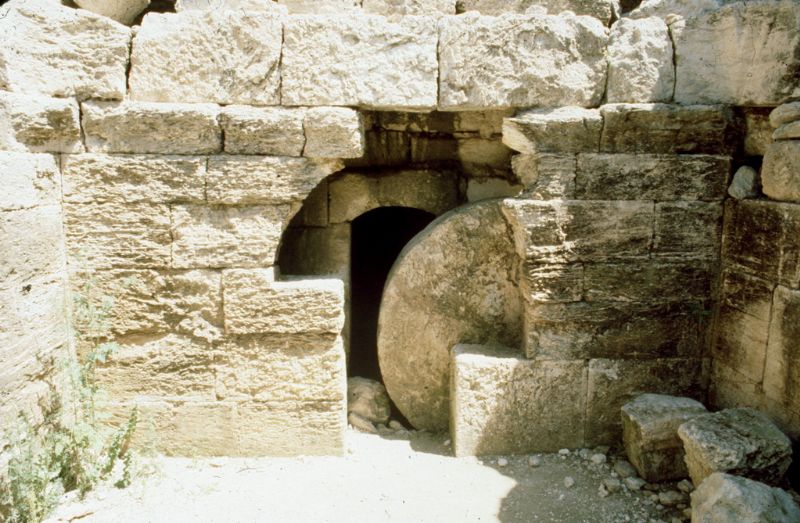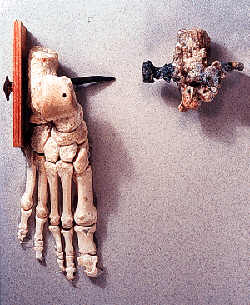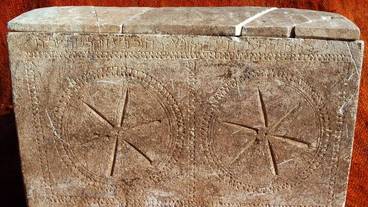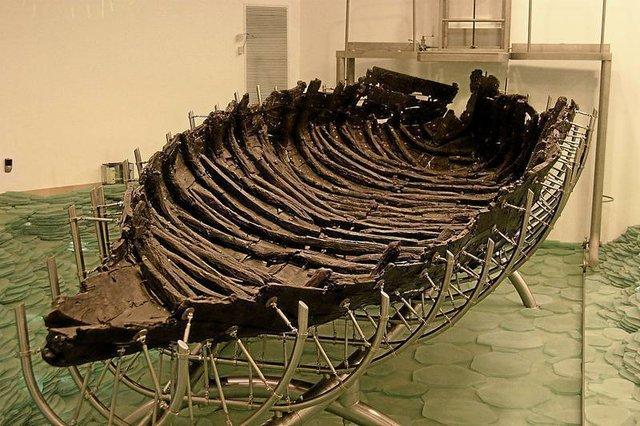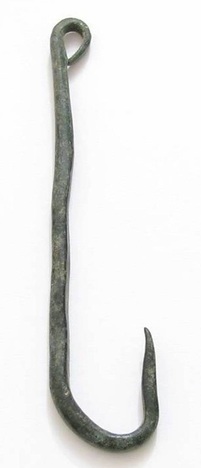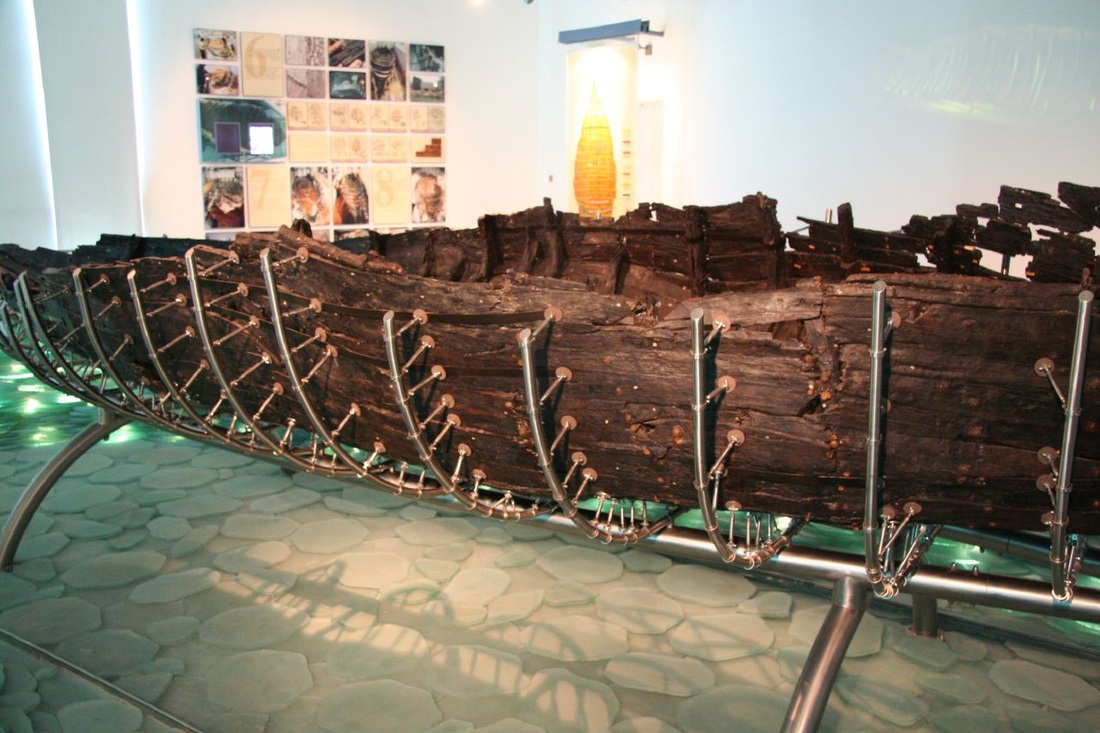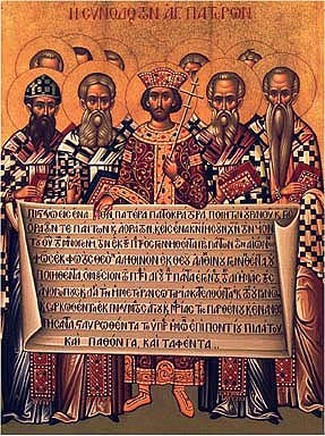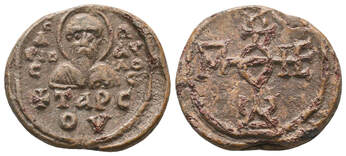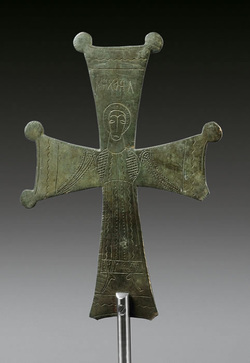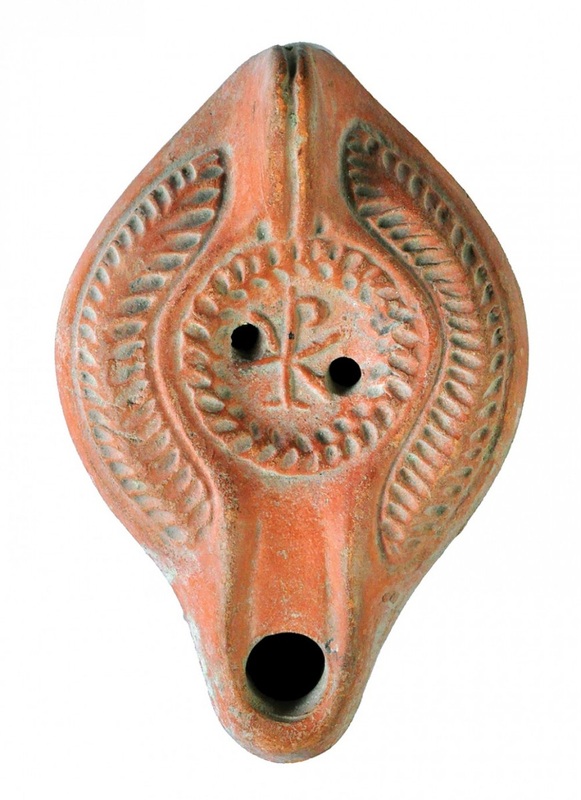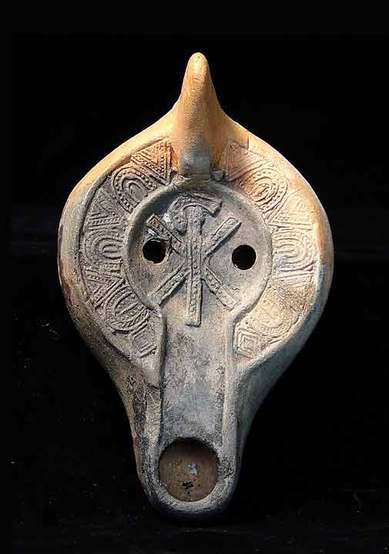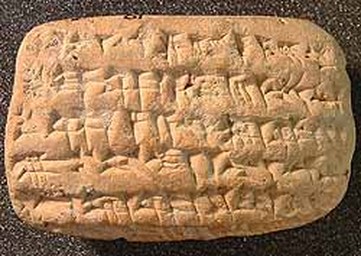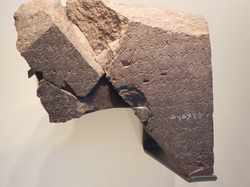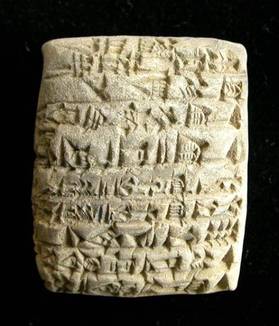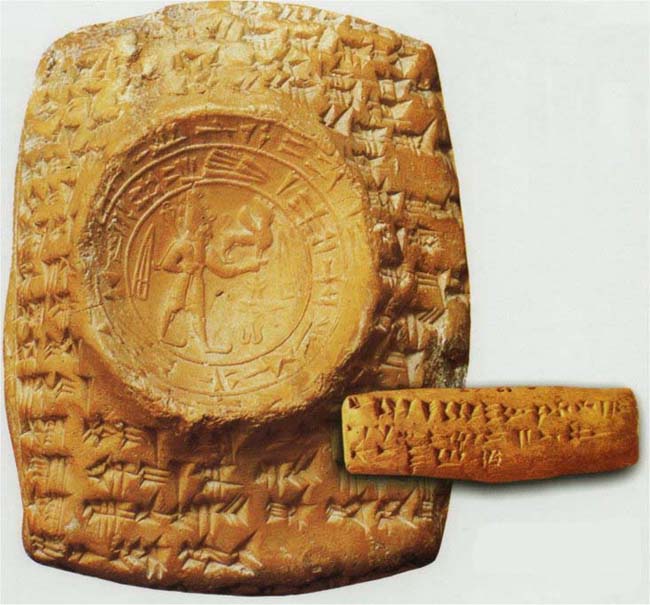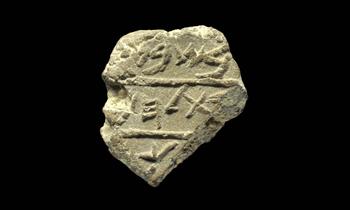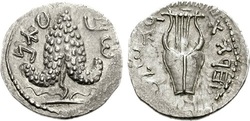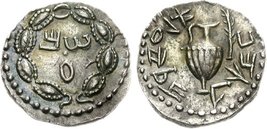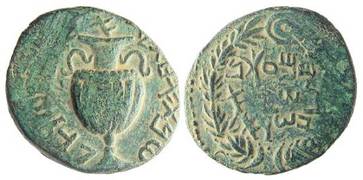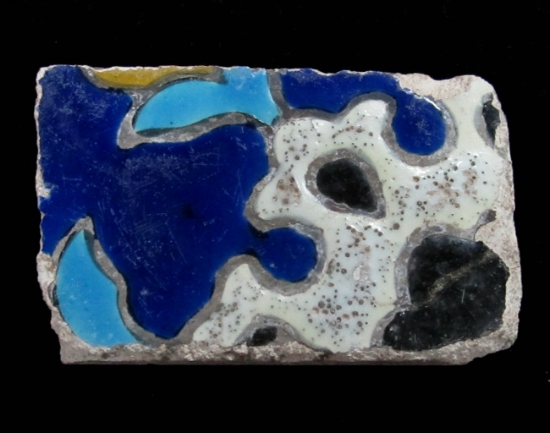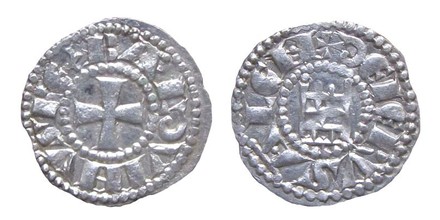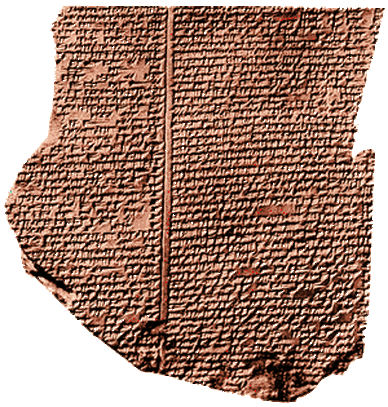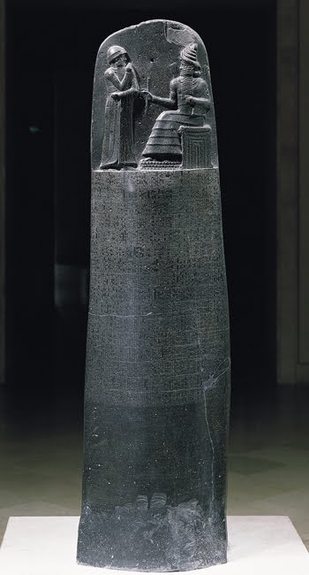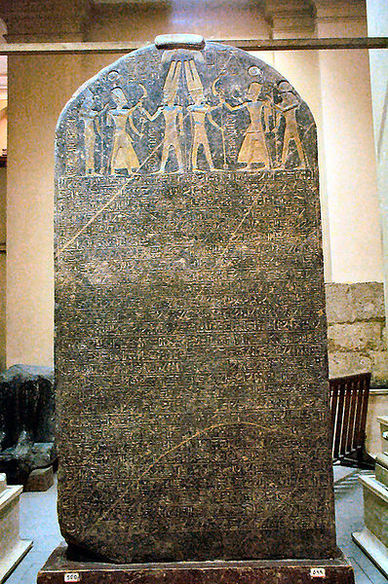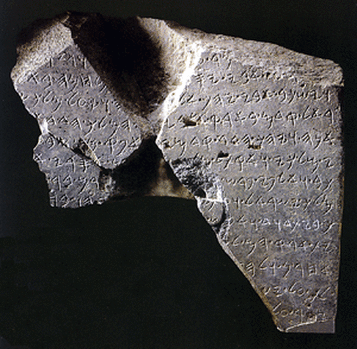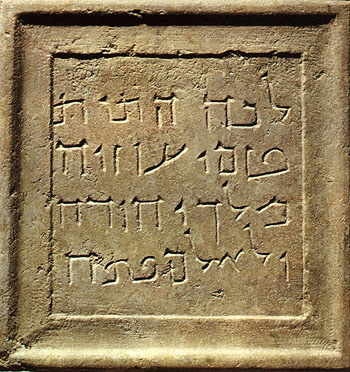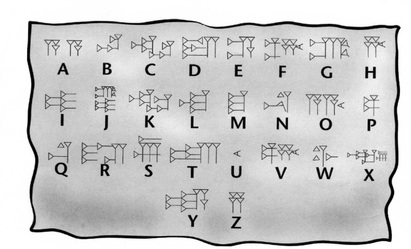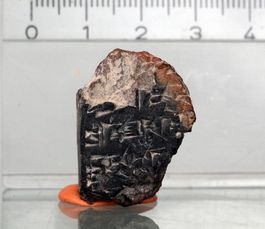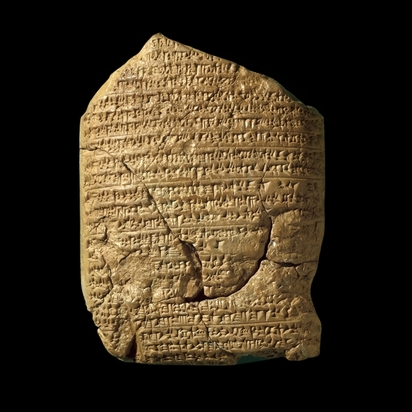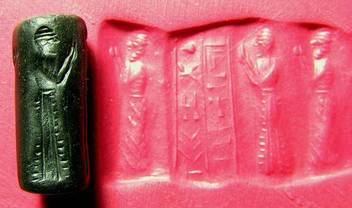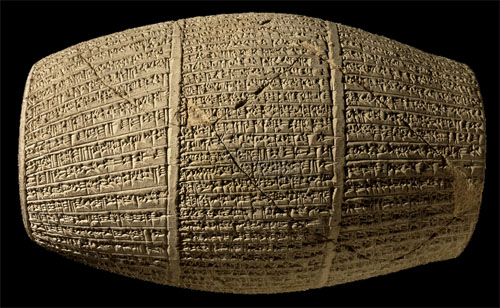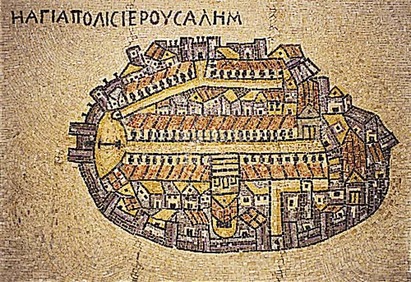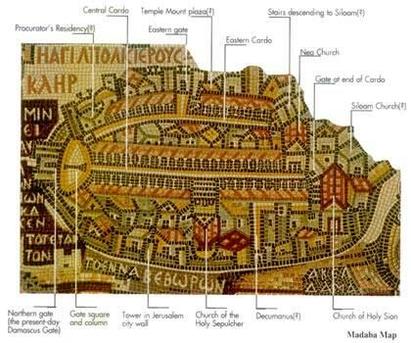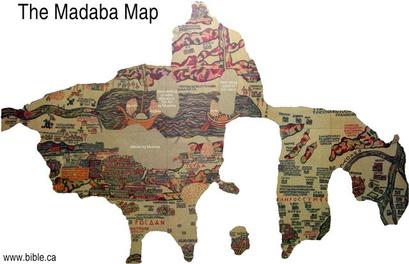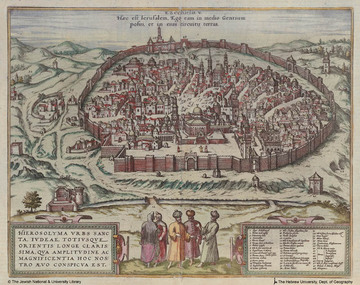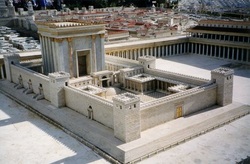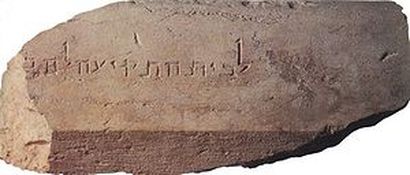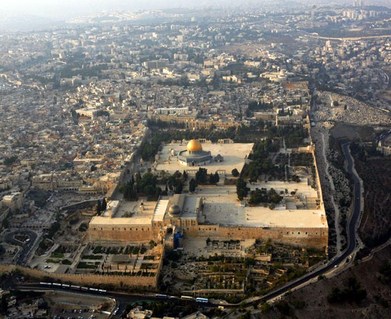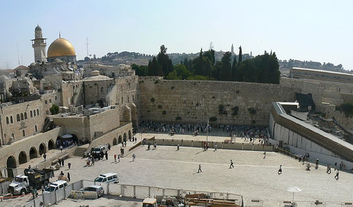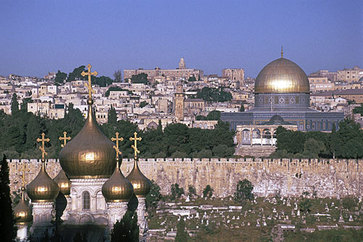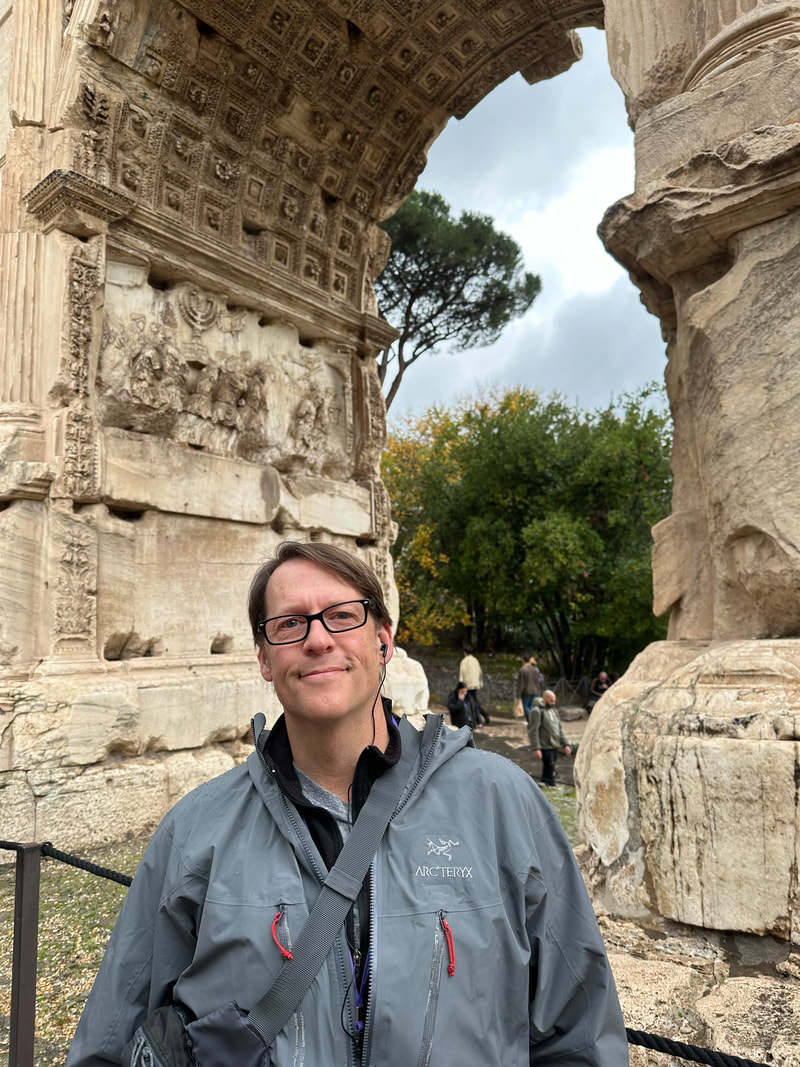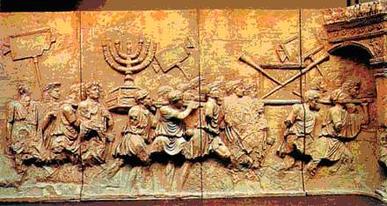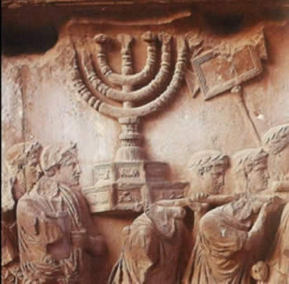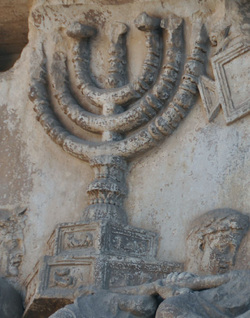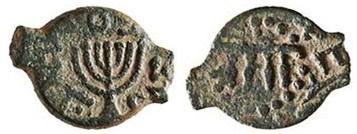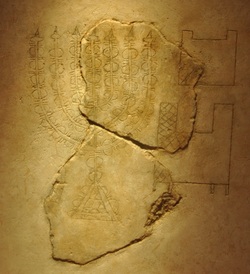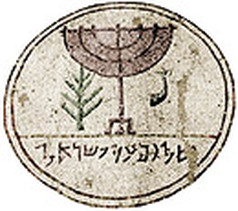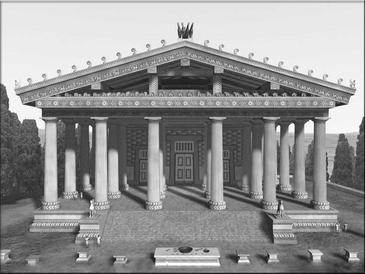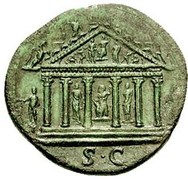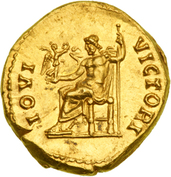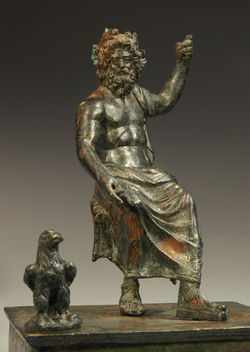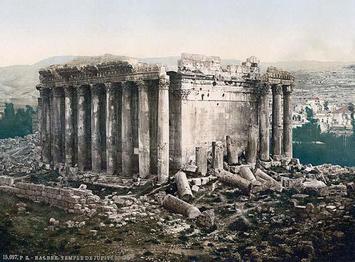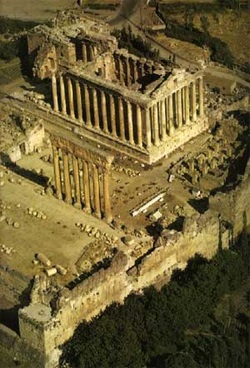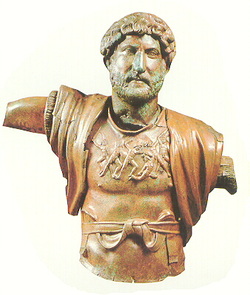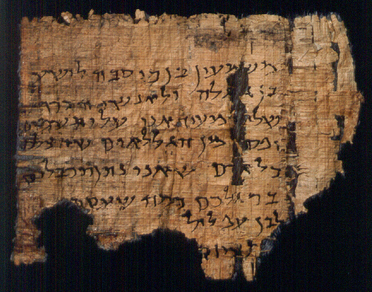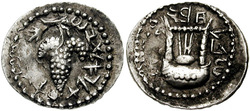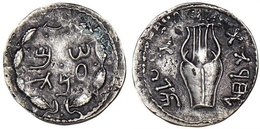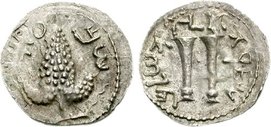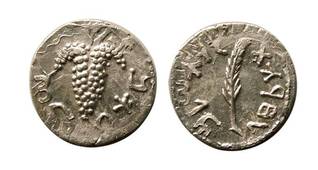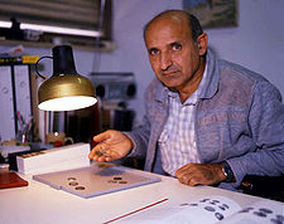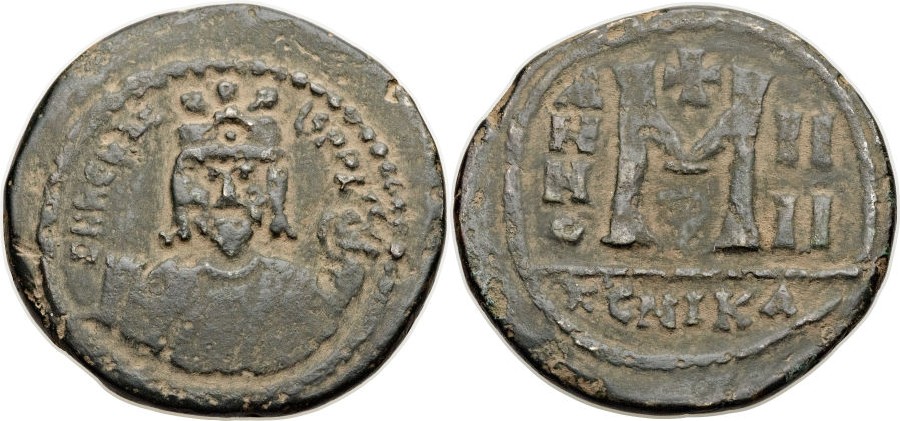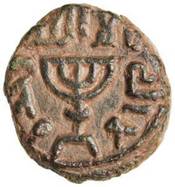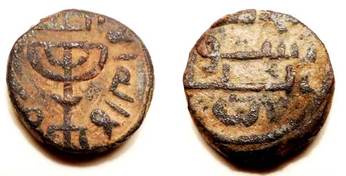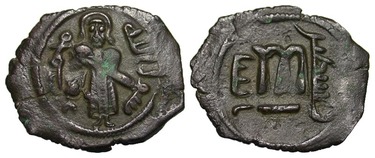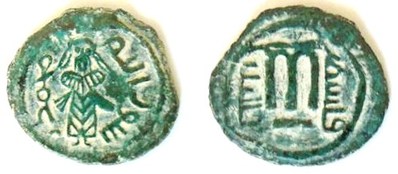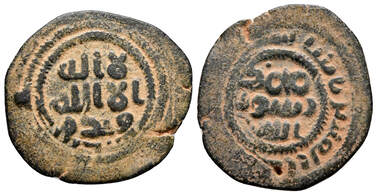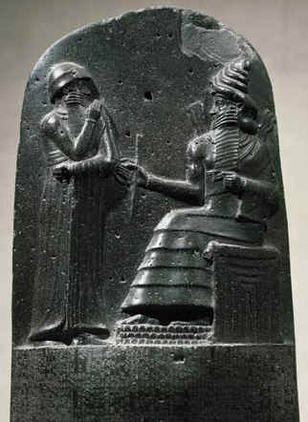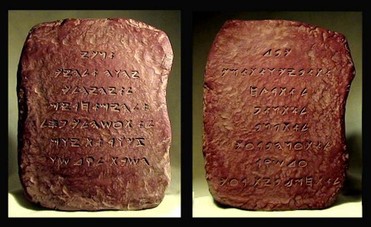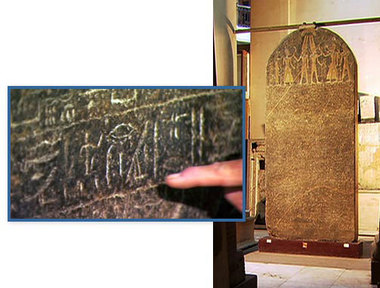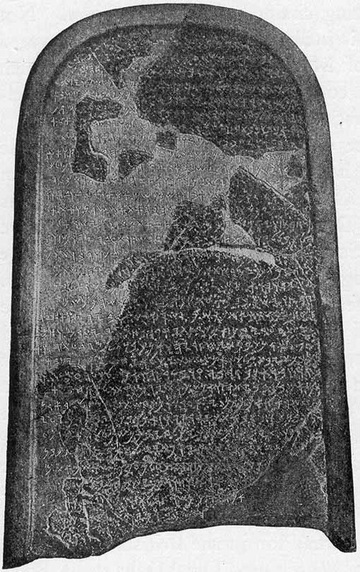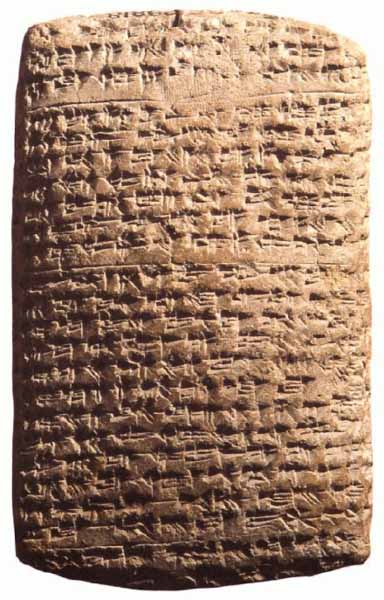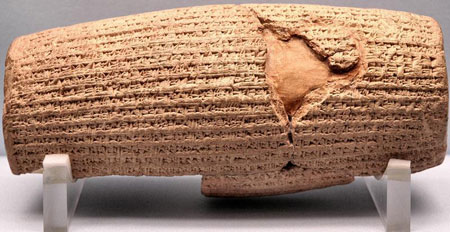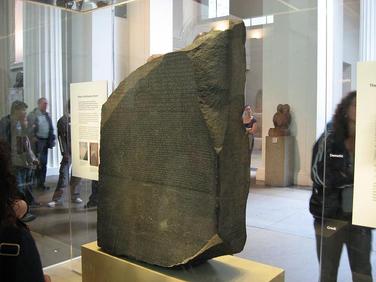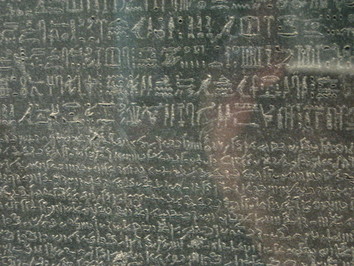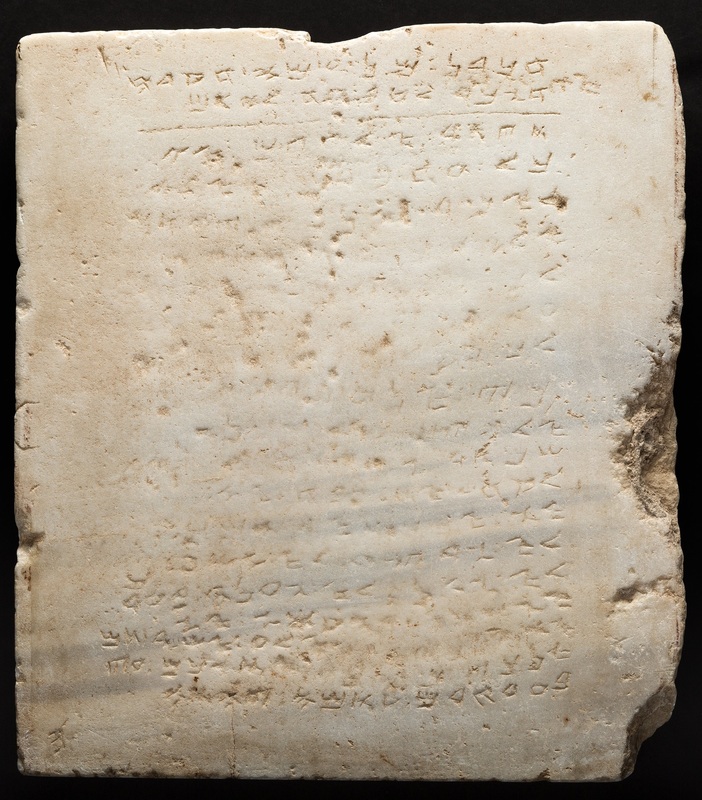Hadrian Travels to Judaea
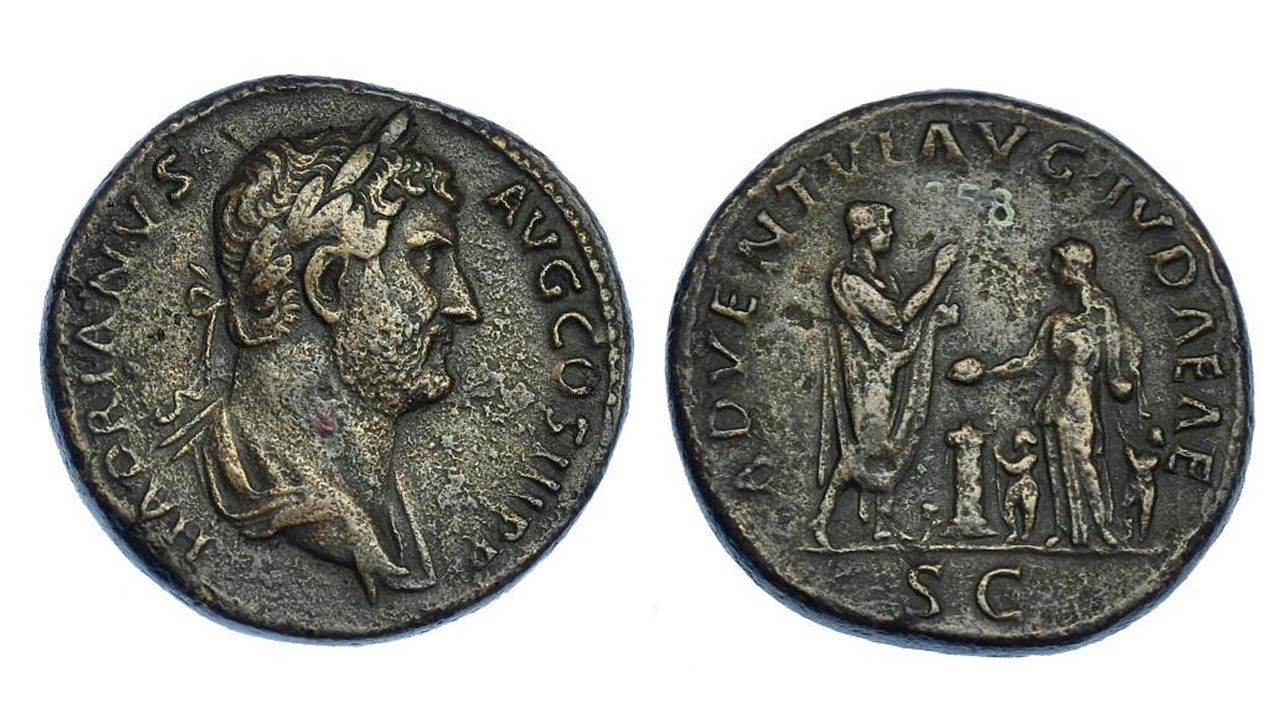
Hadrian 134-138 AD
Minted in Rome
Æ Sestertius 32mm, 27.83g
Obv: Laureate bust and draped right;
HADRIANVS AVG COS III P P. R
Rev: ADVENTVI AVG IVDAEAE,
exergue SC; Hadrian with parchment,
in front Judea to the left. with patera and
cup flanked by two children; between them
altar with calf for the sacrifice
(commemorates Hadrian’s travels)
Ref: RIC 1768
(Author's collection)
The coin shown above belongs to the ADVENTVS series, where the emperor appears standing and robed, in front of the female personification of the province (e.g., Africa, Arabia, Cilicia, Mauritania, Thrace, Britannia, Gaul, Hispania, Italy - in this case, Judaea) accompanied by children. Between them there is an altar and an animal destined for sacrifice, in this case a bull. This series is generally dated between 134 and 138, but, following the Jewish rebellion (the Bar Kochba revolt) the emperor decided to eliminate the name of Judea from the Empire, changing the province's designation to Syria-Palestine (and the city of Jerusalem after himself, Aelia Capitolina). Therefore, it is very likely that this coin was minted prior to that decision, depicting a submissive patron and the emperor as opposed to a province and capital in revolt.

JUDAEA, Bar Kochba Revolt
AR Sela (14.18 g), 132-135 CE
Undated, attributed to year 3 (134/5 CE)
Obv: 'Simon' (Paleo-Hebrew), tetrastyle
façade of the Temple of Jerusalem; show
bread table or Ark of the Covenant in chest
form with semicircular lid and short legs,
seen from a narrow side; above façade, star.
Rev: 'For the freedom of Jerusalem'
(Paleo-Hebrew), lulav with etrog at left.
Ref: Hendin 1411; Mildenberg 87 (O12/R67;
this coin #22); TJC 267.
ex Mel Wacks Collection; Ex Hess-Leu 31
(7 December 1966), 541; NY Sale lot 96
(Author's collection)
The coins above images the façade of the Temple at the time of the Bar Kochba revolt and the destruction of the temple following Hadrian's visit (depicted above)
AELIA CAPITOLINA (JERUSALEM)
The Emperor Publius Aelius Traianus Hadrianus (117-138 AD), following his crushing campaign against the rebellion of Jewish Zealots – known as the Bar Kochba revolt – established a Roman colony of legionnaires in the once capital of Judaea (Jerusalem).
After suppressing the Jewish rebellion, Hadrian proceeded to expel all Jews from Jerusalem and prohibited the Jews from approaching their sacred city upon pain of death (with the exception of one day a year, to mourn the destruction of the First and Second Temples). Moreover, he renamed the city after his family name (Aelia) and after the namesake of Jupiter Capitolinus. Accordingly, he commissioned the construction of a Temple to Jupiter in place of the Jewish Temple located in a prominent position on the temple mount.
Hadrian also began minting coins following these developments to commemorate his achievements. Furthermore, the themes used among this series of coinage facilitated a re-casting the city’s culture from one of Judean sacredness to one reflecting its new pagan Roman legionnaire populace. As Cassius Dio records in the late 2nd century/early third century, Aelia Capitolia was re-settled as a city for Roman legionnaires and their families (dominated by the Tenth Legion, stationed in Jerusalem following the earlier destruction of the city under Titus during the First Jewish War (66-73 AD).
The coins of the colony are inscribed with Latin inscriptions to include various derivations denoting Aelia’s colonial status - COL AEL CAP (Colonia Aelia Capitolina). Coins were minted from Aelia for nearly 120 years comprising the reigns of Hadrian (117-138 AD) through that of Hostilian (251 AD).
Hadrian inaugurated his new coin series by commemorating the construction of Jupiter’s temple (perhaps adding impetus to the Zealots revolt) as well as his founding of the city's new boundaries (a common image among Roman coins used to denote the founding or re-establishing of a city). The image of the emperor, ruler, or priest plowing the boundaries reflects what was called the sulcus primigenius or first furrow. For a more detailed description of these events, readers are referred to an article by David Jacobson (2019) entitled, "The enigma of the name Iliya (=Aelia) for Jerusalem in early Islam."
Coin descriptions and numbering systems used in this section are based on the work of Yaakov Meshorer (1935-2004) the foremost expert in this area of numismatics. Meshorer's seminal reference, "The Coinage of Aelia Capitolina" (1989) serves as the basis for the following corpus of coins.
After suppressing the Jewish rebellion, Hadrian proceeded to expel all Jews from Jerusalem and prohibited the Jews from approaching their sacred city upon pain of death (with the exception of one day a year, to mourn the destruction of the First and Second Temples). Moreover, he renamed the city after his family name (Aelia) and after the namesake of Jupiter Capitolinus. Accordingly, he commissioned the construction of a Temple to Jupiter in place of the Jewish Temple located in a prominent position on the temple mount.
Hadrian also began minting coins following these developments to commemorate his achievements. Furthermore, the themes used among this series of coinage facilitated a re-casting the city’s culture from one of Judean sacredness to one reflecting its new pagan Roman legionnaire populace. As Cassius Dio records in the late 2nd century/early third century, Aelia Capitolia was re-settled as a city for Roman legionnaires and their families (dominated by the Tenth Legion, stationed in Jerusalem following the earlier destruction of the city under Titus during the First Jewish War (66-73 AD).
The coins of the colony are inscribed with Latin inscriptions to include various derivations denoting Aelia’s colonial status - COL AEL CAP (Colonia Aelia Capitolina). Coins were minted from Aelia for nearly 120 years comprising the reigns of Hadrian (117-138 AD) through that of Hostilian (251 AD).
Hadrian inaugurated his new coin series by commemorating the construction of Jupiter’s temple (perhaps adding impetus to the Zealots revolt) as well as his founding of the city's new boundaries (a common image among Roman coins used to denote the founding or re-establishing of a city). The image of the emperor, ruler, or priest plowing the boundaries reflects what was called the sulcus primigenius or first furrow. For a more detailed description of these events, readers are referred to an article by David Jacobson (2019) entitled, "The enigma of the name Iliya (=Aelia) for Jerusalem in early Islam."
Coin descriptions and numbering systems used in this section are based on the work of Yaakov Meshorer (1935-2004) the foremost expert in this area of numismatics. Meshorer's seminal reference, "The Coinage of Aelia Capitolina" (1989) serves as the basis for the following corpus of coins.
Hadrian (117-138 A.D.)
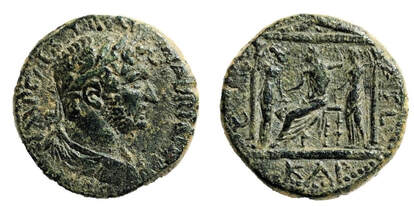
JUDAEA, Aelia Capitolina
Hadrian 117-138 A.D.
Æ 27mm
Obv: Laur. bust of emp. r.
IMP[eratori] CAES[ari] TRAI[ano]
HADRIANVS - “For Imperator
Caesar Trajanus Hadrianus”
Rev: Façade of distyle temple of Jupiter
Capitolinus (Zeus seated in center,
flanked by Minerva and Juno
COL(onia) AEL(ia) KAP(itolina)
- “The Colony of Aelia Capitolina”
Ref: Meshorer, Aelia 1
(Author's collection)
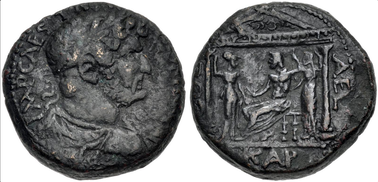
JUDAEA, Aelia Capitolina (Jerusalem). Hadrian. 117-138 CE. Æ (26.5mm, 18.94 g, 11h). Laureate and draped bust right, seen from behind / The Capitoline Triad: Zeus, holding scepter, seated left between Athena standing right, holding spear, and Hera standing left, holding scepter; all within distyle temple. Meshorer, Aelia 1; Kadman, Aelia 3; RPC III 3963; Rosenberger 2; Sofaer 1. ex. Gil Steinberg Collection, purchased from Bowers & Ruddy Galleries, 13 January 1981 (Author's collection)
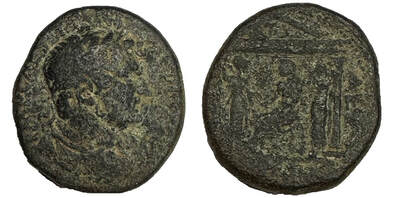
JUDAEA, Aelia Capitolina (Jerusalem). Hadrian. 117-138 CE. Æ 25mm, 16.79g, 11h. Laureate and draped bust right, seen from behind / The Capitoline Triad: Zeus, holding scepter, seated left between Athena standing right, holding spear, and Hera standing left, holding scepter; all within distyle temple. Meshorer, Aelia 1; Kadman, Aelia 3; RPC III 3963; Rosenberger 2; Sofaer 1. ex. Menashe Landman collection (Author's collection)

JUDAEA, Aelia Capitolina
Hadrian 117-138 A.D., Æ 23mm
Obv: Laur. bust of emp. r.
COL(onia) AEL(ia) KAPIT(olina)
COND(ita) - “The founding of the
Colony of Aelia Capitolina”
Rev: Emperor plowing field
IMP[eratori] CAES[ari] TRAI[ano]
HADRIANO AUG[usto] P[ater]
P[atriae] - “For Imperator Caesar
Trajanus Hadrianus Augustus,
Father of the Fatherland.”
Ref: Meshorer, Aelia 2
(Author's collection) - this coin featured in Biblical Archeological Review 23, 6 (1997) - see below
Antoninus Pius 138-161 A.D.
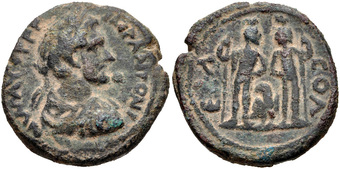
JUDAEA, Aelia Capitolina
Antoninus Pius. 138-161 A.D.
Æ 23mm, 10.12g
Obv: Laur. bust of emp. r.
IMP ANTONINVS AVG PPP
Rev: Dioscuri facing eachother,
hldg spear, eagle between
COA ECA
Ref: Meshorer, Aelia 22
CNG 273, 229
ex. Patrick H.C. Tan collection
ex. Robert Deutch collection
(Author's collection)
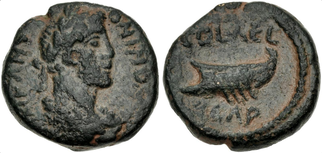
JUDAEA, Aelia Capitolina (Jerusalem)
Antoninus Pius. 138-161 CE.
Æ (15mm, 3.78 g, 7h).
Obv: Laureate, draped, and cuirassed bust
right, seen from behind IMP ANT ONINO AVG
Rev: Galley left COL AEL CAP
Ref: Meshorer, Aelia 31; Kadman, Aelia 34
ex Patrick H. C. Tan Collection
(CNG e299 lot 318 (2013)
(Author's collection)
Marcus Aurelius 161-180 A.D.
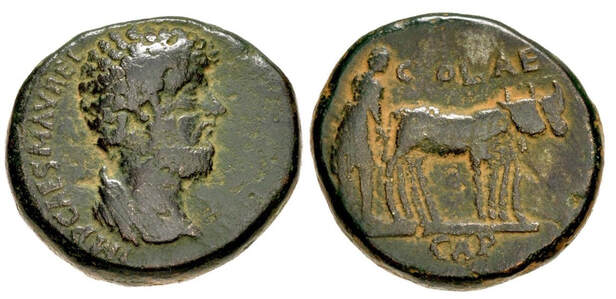
JUDAEA, Aelia Capitolina (Jerusalem). Marcus Aurelius. 161-180 CE. Æ (33mm, 32.54 g, 12h). Foundation issue. Bareheaded and draped bust right / Marcus (as founder) plowing pomerium with yoke of oxen right. Meshorer, Aelia 42; Sofaer –, but cf. 45 (for obv.; same die); RPC IV.3 Online 9269. Earthen green surfaces. VF. Extremely rare, RPC cites only two examples, only two in CoinArchives.
From the Father & Son Collection. Ex Fontanille 48 (5 April 2013), lot 9
(Author's collection)
Commodus 177-192 A.D.
Lucius Verus
Commodus 177-192 A.D.
Septimius Severus 193-211 A.D.
Julia Domna
Caracalla 198-217 A.D.
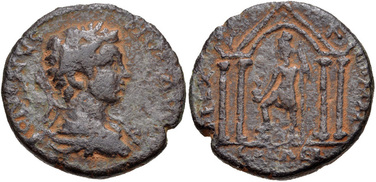
JUDAEA, Aelia Capitolina
Caracalla 198-217 A.D.
Æ 28mm,12.62g
Obv: Laureate bust of emp. r.
ANTONINVSPIVSAVGVSTVS
Rev: Tyche-Astarte stdg l., hldg bust
& scepter w/in arch of tetrastyle
temple façade
COL AELI FELX
Ref: Meshorer, Aelia 86c
CNG 273, 249
ex. Patrick H.C. Tan collection
ex. Robert Deutch collection
(Author's collection)

JUDAEA, Aelia Capitolina
Caracalla 198-217 A.D.
AR Tetradrachm (14.420g)
Obv: Laur. bust of emp. r.
AVT KAI ANTΩNINOC
Rev: Eagle standing facing, head left,
on thyrsus bound with fillet, with
wings displayed, holding wreath in
beak; vine leaf between legs
ΔHMAPX EΞ YΠATOC TO A
Ref: Meshorer, Aelia 95; Prieur 1617
(Author's collection)

JUDAEA. Aelia Capitolina (Jerusalem). Caracalla, 198-217. Tetradrachm (Silver, 27 mm, 13.00 g, 12 h), 215-217. ΑΥΤ ΚΑΙ ΑΝΤωΝΙΝΟC CЄ Laureate, draped and cuirassed bust of Caracalla to right, seen from front. Rev. ΔΗΜΑΡΧ ΕΞ ΥΠΑΤΟC Τ Δ Eagle standing facing on filleted thyrsos with wings spread, head to left and holding wreath in beak; between the eagle's legs, wine jar. Prieur 1626-7 var (Author's collection)
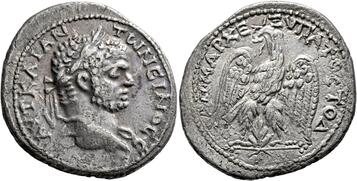
JUDAEA, Aelia Capitolina (Jerusalem)
Caracalla, 198-217 AD.
AR Tetradrachm (31 mm, 12.64 g, 12 h).
Obv: AYT KAI AN-TⲰNЄINOC C
Laureate bust of Caracalla to right,
slight drapery on his left shoulder
Rev: ΔΗΜΑΡΧ Ε-Ξ ΥΠΑΤΟC ΤO Δ
Eagle standing facing on thyrsos, head
left, holding wreath in beak; between
legs, vine leaf.
Ref: Prieur 1615; Leu 30 lot 1584
(Author's collection)

JUDAEA, Aelia Capitolina
Caracalla. 198-217 AD.
AR Tetradrachm, 27mm, 13.9g
Obv: Laur. bust of emp. r.
AVT KAI ANTΩNINOC
Rev: Eagle standing facing, head l.,
on thyrsus bound with fillet, with
wings displayed, holding wreath
in beak; vine leaf between legs
ΔHMAPX EΞ YΠATOC TO A
Ref: Meshorer, Aelia 94;
Prieur 1620A (one specimen cited by Prieur (Author's collection)
Macrinus 217-218 A.D.
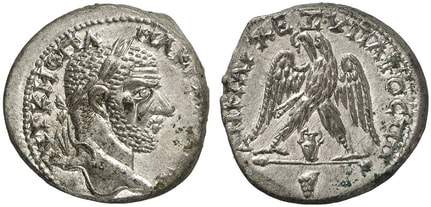
JUDAEA, Aelia Capitolina
Macrinus 217-218 A.D.
AR Tetradrachm (12.71g). Obv .: AΥT K M OΠΛ MAKΡ [INO ΣEB], bust with laurel wreath, seen from behind to the right. Rev .: ΔHMAΡX EΞ ΥΠATOΣ ΠΠ, eagle with a wreath in its beak stands with spread legs on a thyrsos, head to the left, amphora between the legs, in the section of grapes. Prieur 1640; Meshorer, Aelia 96; ex Gorny & Mosch 211 lot 498
(Author's collection) - one of the finest known examples

JUDAEA. Aelia Capitolina (Jerusalem).
Macrinus, 217-218 AD.
AR Tetradrachm 27 mm, 13.13 g, 1 h
Obv: ΑΥΤ Κ Μ ΟΠΛ (sic) ΜΑΚΡΙΝΟ C[ЄΒ]
Laureate head of Macrinus to right.
Rev: ΔΗΜΑΡΧ ЄΞ ΥΠΑΤΟC ΠΠ Eagle
standing facing on filleted thyrsos with wings
spread, head to left and holding wreath in beak;
between the eagle's legs, wine jar.
Ref: Bellinger -. Prieur 1638 (same obverse)
(Author's collection)
Diadumenian 217-218 A.D.
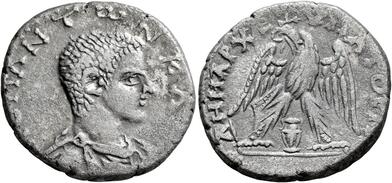
JUDAEA, Aelia Capitolina (Jerusalem)
Diadumenian, as Caesar, 217-218 AD.
AR Tetradrachm (25 mm, 11.70 g, 7 h).
Obv: M OΠ ANTⲰN KAI Bare headed,
draped and cuirassed bust of Diadumenian to right
Rev: ΔΗΜΑΡΧ ЄΞ ΥΠΑΤΟC ΠΠ
Eagle standing facing on thyrsos with
wings spread, head to left and holding
wreath in beak; between the eagle's legs, wine jar.
Ref: Bellinger -. Prieur 1645 (one example)
ex Leu Web Auction 28, 2697 (2023)
(Author's collection)
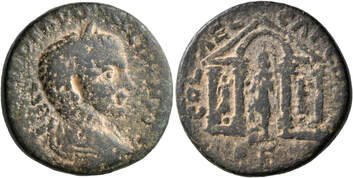
JUDAEA. Aelia Capitolina (Jerusalem). Diadumenian, as Caesar, 217-218. AE (Bronze, 23 mm, 10.47 g, 1 h). M OPEL DIADVMENIANVS C Laureate, draped and cuirassed bust of Diadumenian to right, seen from behind. Rev. COL AEL CAP COMM Tyche-Astarte standing front, head to left, right foot on uncertain object, holding small human bust in her right hand and scepter in her left, within tetrastyle temple with central arch; Nikai between outer columns. Meshorer 106 W. Bick Collections, ex Archeological Center 52, 9 April 2012, 114 (Author's collection)
Elagabalus 218-222 A.D.
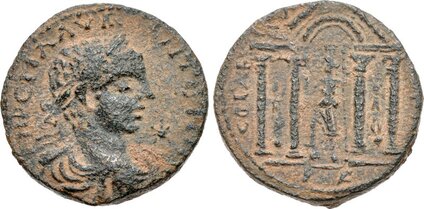
JUDAEA, Aelia Capitolina
Elagabalus 218-222 A.D.
Æ 23mm, 7.39g
Obv: Laur. bust of emp. r.
IMPCMAVR ANTONINVS AVG
Rev: Tyche-Astarte l., hldg bust w/in
tetrastyle temple, central arch
COLA CAPC MPF
Ref: Meshorer, Aelia 125c
CNG 90, 1199
ex. Patrick H.C. Tan collection
ex. Robert Deutch collection
(Author's collection)
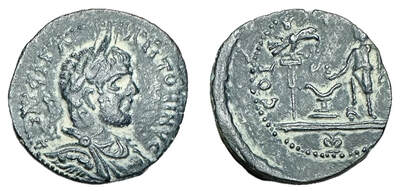
JUDAEA, Aelia Capitolina (Jerusalem). Elagabalus 218-222 A.D.
AE 25mm
Obv: Laur. bust of emp. r.
IMP C M AVR ANTONINVS AVG
Rev: Tyche standing left, right foot
on helmet, holding small bust over
horned altar and scepter;
aquila to left, cup in exergue
COL AAELC CA PFF
Reference: Meshorer 129a (Author's collection)
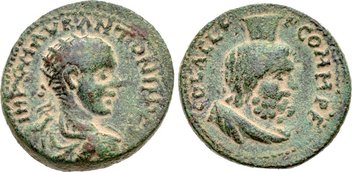
JUDAEA, Aelia Capitolina
Elagabalus 218-222 A.D.
Æ 22mm, 8.79g
Obv: Radiate bust of emp. r.
IMPCMAVR ANTONINVSA
Rev: Draped bust of Serapis, r.
COLAEL CAPCOMM PF
Ref: Meshorer, Aelia 135
CNG 90, 1202
ex. Patrick H.C. Tan collection
ex. Robert Deutch collection
(Author's collection) - featured on followinghadrian.com
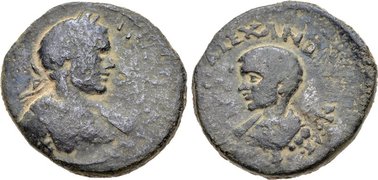
JUDAEA, Aelia Capitolina
Elagabalus 218-222 A.D.
Æ 24mm, 10.86g
Obv: Laur. bust of emp. r.
IMP CMAAN TONINVS
Rev: Bareheaded, draped bust of
Severus Alexander, l.
MAVSEALEXANDRVSN
Ref: Meshorer, Aelia 139
CNG 90, 1204
ex. Patrick H.C. Tan collection
ex. Robert Deutch collection
(Author's collection)
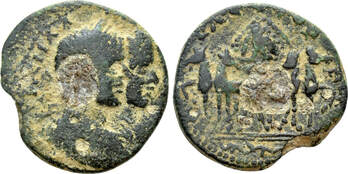
JUDAEA, Aelia Capitolina.
Elagabalus; Severus Alexander 218-222 AD
Æ 23mm, 8.61g
Obv: Jugate, laureate, draped and cuirassed busts of Elagabalus and Severus Alexander right.
Rev: Facing quadriga carrying the baetyl of El-Gabal decorated with eagle; branch in exergue.
Ref: Meshorer 143.
(Author's collection)
Trajan Decius 249-251 A.D.
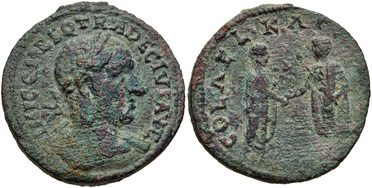
JUDAEA, Aelia Capitolina (Jerusalem). Trajan Decius. AD 249-251. Æ (27mm, 12.78 g, 12h). Laureate and cuirassed bust right, seen from behind / Etruscus and Hostilian standing vis-à-vis, clasping hands. Meshorer, Aelia 156; Kadman 172; Rosenberger -; SNG ANS 628. ex CNG 239, lot 414 (Author's collection)
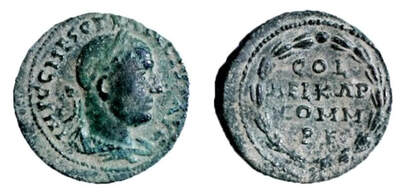
JUDAEA, Aelia Capitolina (Jerusalem). Trajan Decius. AD 249-251. Æ (28mm, 16.79 g, 1h). Laureate, draped, and cuirassed bust right / COL/ AEL KAP/ COMM/ •P F• in four lines within laurel wreath. Meshorer, Aelia 157; Sofaer 144. Ex Classical Numismatic Group Electronic Auction 239 (25 August 2010), lot 415 (Author's collection)
Herenius Etruscus

JUDAEA, Aelia Capitolina (Jerusalem)
Herennius Etruscus. AD 249-251.
Æ (25mm, 12.79 g, 12h).
Obv: Radiate, draped, and cuirassed
bust right, seen from behind QHERETR
MESDECIOCAES
Rev: Tyche standing left, right foot
on helmet, holding small bust and scepter,
crowned by Nike standing on column to
right; to left, aquila and cantharus.
COLAE LK APCOMPF
Ref: Meshorer, Aelia 166; Kadman, Aelia 182
CNG e566 lot 447
(Author's collection)
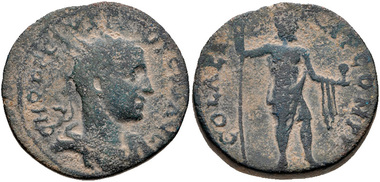
JUDAEA, Aelia Capitolina (Jerusalem). Herennius Etruscus. As Caesar, AD 249-251. Æ 27mm, 16.83 g, 1h. Radiate and draped bust right / Zeus or Serapis standing right, holding scepter and small bust. Cf. Meshorer, Aelia 171 (description notes thyrsos between scepter and figure, although not visible in illustration); Sofaer 156. Ex Classical Numismatic Group Electronic Auction 251 (9 March 2011), lot 248 (Author's collection)

JUDAEA, Aelia Capitolina (Jerusalem). Herennius Etruscus. As Caesar, AD 249-251. Æ 27mm, 13.93g, 1h. Radiate and draped bust right / Zeus or Serapis standing right, holding scepter and small bust. Cf. Meshorer, Aelia 171 (description notes thyrsos between scepter and figure, although not visible in illustration); Sofaer 156. ex. Menashe Landman coll. (Haifa) (Author's collection)
Hostilian
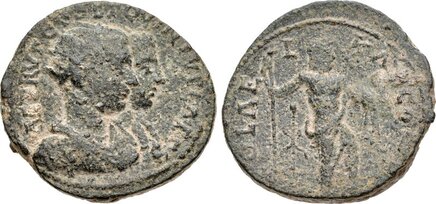
JUDAEA, Aelia Capitolina
Herenius Etruscus 250-251 A.D.
Æ 26mm, 14.72g
Obv: Judate busts of Etruscus
and Hostilian
AETRVSCVS ET QVINTVS CAESS
Rev: Zeus stdg r., leaning on scepter
hldg bust; thyrsus between
COLAE L KAPCOMPF
Ref: Meshorer, Aelia 174
CNG 90, 1211
ex. Patrick H.C. Tan collection
ex. Robert Deutch collection
(Author's collection)
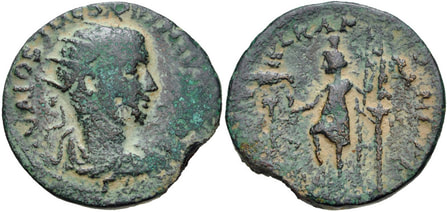
JUDAEA, Aelia Capitolina (Jerusalem). Hostilian. AD 251. Æ (28mm, 11.13 g, 1h). Radiate and draped bust right / Tyche standing left, holding small bust and leaning on scepter, being crowned by Nike on short column behind her; aquila to left. Meshorer, Aelia 179a; Rosenberger 99 var. (wine jug before Tyche); SNG ANS - (Author's collection)
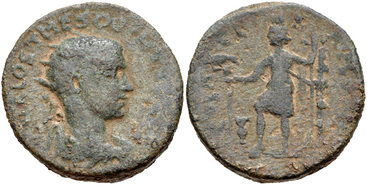
JUDAEA, Aelia Capitolina (Jerusalem). Hostilian. As Caesar, CE 250-251. Æ (28mm, 16.60 g, 1h). Radiate, draped, and cuirassed bust right / Tyche standing left, holding small bust and leaning on scepter, being crowned by Nike on short column to right; aquila and cantharus to left. RPC IX Online 2176.12 = 2176.15 (this coin cited) = Meshorer, Aelia 179 (this coin illustrated); Rosenberger 99; Sofaer 161 var. (no cantharus); SNG ANS –.
Ex Patrick H. C. Tan Collection (Classical Numismatic Group Electronic Auction 273, 8 February 2012), lot 264 (incorrectly attributed as Trajan Decius); N. Miron Collection (Author's collection)
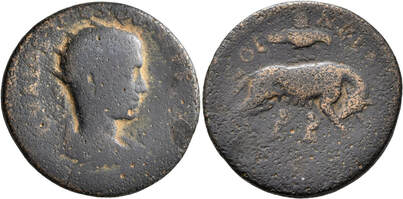
JUDAEA. Aelia Capitolina (Jerusalem). Hostilian, as Caesar, 250-251. AE (29 mm, 14.39 g, 1 h). [C VAL OST MES QVINTVS CAE] Radiate, draped and cuirassed bust of Hostilian to right, seen from behind. Rev. COL AEL [KAP COMM P F] She-wolf standing right, suckling Romulus and Remus; behind, aquila. Meshorer 181. RPC IX 2198. Nearly fine.
From the Aelia Capitolina Collection and the Shoshanna Collection Part I, Heritage, 9 March 2012, 40.
(Author's collection)
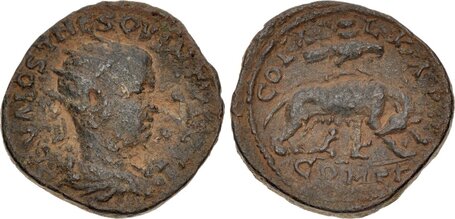
JUDAEA, Aelia Capitolina (Jerusalem). Hostilian. As Caesar, AD 250-251. Æ (28mm, 12.69 g, 11h) [C VAL OST MES QVINTVS CAE] Radiate, draped and cuirassed bust of Hostilian to right, seen from behind. Rev. COL AEL [KAP COMM P F] She-wolf standing right, suckling Romulus and Remus; behind, aquila. Meshorer, Aelia 181; RPC IX 2198; Rosenberger 100; Sofaer 162 ex Abramowitz collection (Author's collection)

